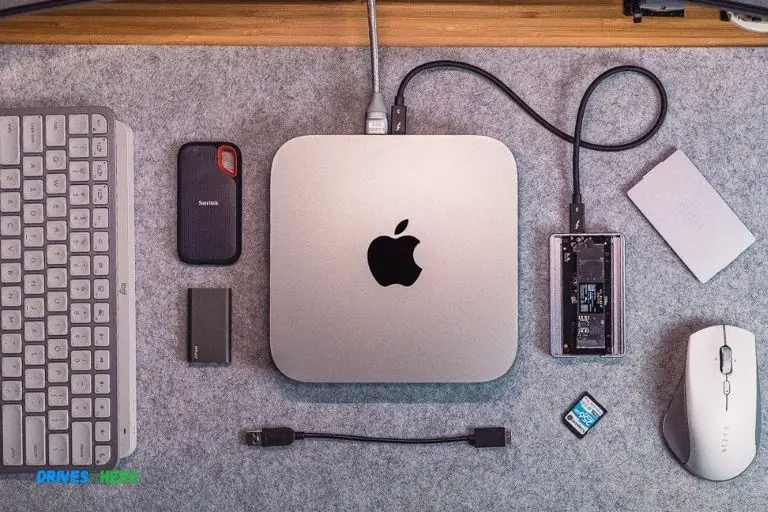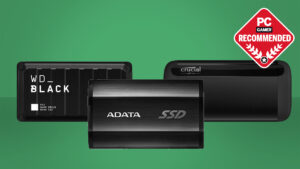How to Run Imac from External Ssd: 7 Step Guide!
To run your iMac from an external SSD (Solid State Drive), you first need to format the SSD, install macOS on it, and then set your iMac to start up from the external SSD.
The internal hard drive of an iMac can become slow over time, affecting the performance of your iMac.
An external SSD can provide faster data access speeds, thereby improving the performance of your iMac.
Furthermore, having an external drive as your startup disk can provide additional storage and backup options.
To run your iMac from an external SSD, start by formatting your SSD using Disk Utility.
Once formatted, install macOS on the SSD by booting your iMac in recovery mode.
After the installation, go to System Preferences, select Startup Disk, and choose your external SSD.
Following these steps will let your iMac run from the external SSD, potentially boosting its performance and providing additional storage space.
7 Steps: Running iMac From External SSD
| Steps | Description | Additional Information |
|---|---|---|
| 1 | Backup Data | Before doing anything, ensure all your important data is backed up. |
| 2 | Purchase SSD | Purchase an external SSD that is compatible with your iMac model. |
| 3 | Format SSD | Format the SSD using Disk Utility on your iMac to make sure it’s in a format that MacOS can boot from. |
| 4 | Install MacOS | Once the SSD is formatted, install MacOS on the external SSD. |
| 5 | Set SSD as Boot Drive | Once MacOS is installed on the external SSD, set it as the default boot drive in System Preferences. |
| 6 | Reboot iMac | Reboot your iMac. If everything has been done correctly, it should now be running from the external SSD. |
| 7 | Verify Setup | Check “About This Mac” in the Apple menu to verify that the startup disk is now your external SSD. |
Key Takeaway

Five Facts About: Running iMac From External SSD
Benefits Of Running Imac From External Ssd
Boost your iMac’s performance by running it from an external SSD. Experience faster speeds, improved multitasking, and seamless data transfer with this simple yet effective solution.
Say goodbye to slow loading times and enjoy a smoother computing experience.
Improved Performance And Speed:
- Running your iMac from an external SSD can significantly enhance its overall performance and speed.
- With an external SSD, you can experience faster boot times, quicker app launches, and smoother multitasking.
- The SSD’s faster data transfer speeds eliminate lag and loading times, providing a seamless and efficient user experience.
- Your iMac will run more smoothly, allowing you to work, create, or play without any frustrating delays.
- Unlike traditional hard drives, SSDs have no moving parts, reducing the risk of mechanical failures and resulting in more reliable and consistent performance.
Increased Storage Capacity:
- One of the major benefits of using an external SSD with your iMac is the extra storage capacity it offers.
- By connecting an external SSD, you can expand your iMac’s storage without having to replace the internal drive or clutter your computer with additional external hard drives.
- This increased storage capacity allows you to store more files, applications, and multimedia content, such as photos, videos, and music, without worrying about running out of space.
- Whether you are a creative professional, a digital nomad, or a casual user, the added storage capacity provided by an external SSD is invaluable for organizing and managing your digital life.
Enhanced Data Security:
- Running your iMac from an external SSD can provide enhanced data security, safeguarding your important files and personal information.
- With an external SSD, you can easily enable encryption and password protection to protect your data from unauthorized access.
- In the event of a system crash or hardware failure, your data stored on the external SSD remains safe, as it is not directly affected by any internal issues.
- Additionally, external SSDs are generally more robust and resistant to physical damage, minimizing the risk of data loss due to accidental drops or impacts.
- By leveraging the benefits of an external SSD, you can ensure the security and integrity of your valuable data, giving you peace of mind.
Running your iMac from an external SSD offers numerous advantages, including improved performance and speed, increased storage capacity, and enhanced data security.
With these benefits, you can optimize your iMac’s performance, expand its storage capabilities, and protect your valuable data.
Upgrade your iMac experience and enjoy the benefits of an external SSD today!
Understanding Ssds For Imac
Learn how to optimize your iMac performance by running it from an external SSD.
Enhance speed, storage capacity, and overall efficiency with this simple and effective solution.
If you’re looking to enhance the performance of your iMac, one effective solution is to run it from an external SSD (Solid State Drive).
SSDs have gained popularity in recent years due to their improved speed and reliability compared to traditional hard drives.
In this section, we will explore what SSDs are, why they are a better choice than traditional hard drives, and suitable SSD options for your iMac.
What Are Ssds?
- SSDs are storage devices that use flash memory to store data, making them much faster than traditional hard drives.
- Unlike traditional hard drives, SSDs have no moving parts, which makes them more durable and less prone to damage caused by physical shock.
- SSDs offer quicker boot times, faster data transfer rates, and shorter application load times, leading to a smoother overall user experience.
- These drives are available in various storage capacities, ranging from a few hundred gigabytes to several terabytes, to cater to different user needs.
Why Choose Ssds Over Traditional Hard Drives?
- Improved Speed: SSDs are significantly faster than traditional hard drives due to their flash memory technology, which allows for faster data retrieval and transfer.
- Enhanced Reliability: With no moving parts, SSDs are less susceptible to mechanical failure, making them more reliable and durable over time.
- Energy Efficiency: SSDs consume less power than traditional hard drives, which can result in longer battery life for laptops and lower electricity costs for desktops.
- Noiseless Operation: The absence of moving parts in SSDs eliminates the noise produced by traditional hard drives, providing a quieter working environment.
Suitable Ssd Options For Imac
External SSDs:
These are portable SSDs that you can connect to your iMac via USB, Thunderbolt, or other compatible interfaces. They are easy to set up and provide an instant performance boost to your iMac.
Internal SSD Upgrades:
If you’re comfortable with opening up your iMac, you can replace the internal hard drive with an SSD.
This option requires technical expertise but offers the advantage of a faster and more seamless integration with your iMac.
Fusion Drives:
Some iMac models come with Fusion Drives, which combine a traditional hard drive with a smaller SSD.
Fusion Drives automatically manage data storage, utilizing the SSD for frequently accessed files and the traditional hard drive for long-term storage.
SSDs are an excellent choice for upgrading your iMac’s storage system.
They offer improved speed, reliability, energy efficiency, and a noiseless operation compared to traditional hard drives.
Whether you prefer an external SSD, an internal upgrade, or a Fusion Drive option, incorporating an SSD into your iMac setup will undoubtedly enhance its overall performance.
Preparing Your Imac For External Ssd
Prepare your iMac for an external SSD by following these steps to easily run your iMac from the SSD for improved performance and storage capacity.
If you’re considering running your iMac from an external SSD, there are a few important steps you’ll need to take to prepare your device.
From backing up your data to ensuring compatibility, and gathering the necessary cables and connectors, these preparations will ensure a smooth transition.
Let’s dive into each step in detail:
Backup Your Data:
- Before making any changes to your iMac, it’s crucial to back up your data. This will protect your files and ensure that you can restore them if anything goes wrong during the process.
- Connect an external hard drive or use a cloud storage service to create a backup of all your important files, including documents, photos, videos, and any other data you want to preserve.
Ensure Compatibility Between Imac And External Ssd:
- Not all iMac models support booting from an external SSD. Before proceeding, verify that your iMac model is compatible with this setup.
- Check the specifications or consult the manufacturer’s website to confirm compatibility. This will save you the trouble of investing in an external SSD that won’t work with your iMac.
Necessary Cables And Connectors:
- To successfully run your iMac from an external SSD, gather the necessary cables and connectors to establish a connection between the two devices.
- You will typically need a Thunderbolt or USB-C cable, depending on the ports available on your iMac and the external SSD. Ensure you have the appropriate cable to establish a reliable connection.
Preparing your iMac for an external SSD doesn’t have to be complicated.
By backing up your data to safeguard against any mishaps, ensuring compatibility between your iMac model and the external SSD, and gathering the necessary cables and connectors, you’ll be well on your way to running your iMac seamlessly from an external SSD.
Steps To Install External Ssd On Imac
Discover the simple steps to install an external SSD on iMac and boost its performance effortlessly.
Unleash the power of running your iMac from an external SSD and experience enhanced speed and efficiency like never before.
To enhance the performance of your iMac, installing an external SSD is a great option.
It allows you to enjoy faster read and write speeds, improved storage capacity, and smoother overall performance.
In this guide, we will walk you through the steps to install an external SSD on your iMac.
Selecting The Right External Ssd
Before diving into the installation process, it’s crucial to select the right external SSD for your iMac.
Consider the following factors when making your choice:
- Compatibility: Ensure that the SSD is compatible with your iMac model and operating system.
- Capacity: Determine the storage capacity you require, based on your usage needs.
- Speed: Look for an SSD with high read and write speeds to maximize performance.
- Connectivity: Choose between Thunderbolt, USB-C, or USB-A connections, based on the ports available on your iMac.
Formatting The External Ssd
Once you have chosen the suitable external SSD, the next step is to format it to be compatible with your iMac.
Here’s how you can do it:
- Connect the external SSD to your iMac using the appropriate cable or adapter.
- Open “Finder” and locate the “Applications” folder.
- Open the “Utilities” folder and launch “Disk Utility.”
- In the left sidebar of Disk Utility, you should see your external SSD listed.
- Click on the SSD and then click on the “Erase” button in the toolbar.
- Choose a name for your SSD and select the format as “Mac OS Extended (Journaled).”
- Click on “Erase” to begin the formatting process.
Physically Connecting The Ssd To Your Imac
Once your SSD is formatted, you can proceed with physically connecting it to your iMac.
Follow these steps:
- Ensure that both your iMac and the external SSD are powered off.
- Locate the appropriate port on your iMac for connecting the SSD (depending on the type of connection chosen).
- Connect one end of the cable or adapter to the SSD, and the other end to the designated port on your iMac.
- Power on your iMac and wait for it to detect the external SSD.
- Once the SSD is recognized, you can begin using it by transferring files or installing applications directly onto it.
Congratulations! You have successfully installed and connected an external SSD to your iMac.
Enjoy the improved speed and expanded storage capacity for a more efficient computing experience.
(Note: Always refer to the manufacturer’s instructions for detailed information specific to your external SSD and iMac model)
Configuring Imac To Run From External Ssd
Easily configure your iMac to run from an external SSD with these simple steps.
Enhance your computer’s performance and storage capacity without any hassle.
Configuring your iMac to run from an external SSD can significantly boost your device’s performance and storage capacity.
By following these steps, you can seamlessly transition to a faster and more spacious storage solution for your iMac.
Accessing The Startup Disk Preferences
To begin the process of running your iMac from an external SSD, you will need to access the Startup Disk preferences.
Follow these steps:
- Click on the Apple menu icon located at the top left corner of your screen.
- Select “System Preferences” from the drop-down menu.
- In the System Preferences window, click on “Startup Disk.“
- You may need to enter your administrator password to proceed.
Selecting The External Ssd As The Default Startup Disk
Once you have accessed the Startup Disk preferences, it’s time to select the external SSD as the default startup disk.
Here’s how:
- Locate the external SSD in the list of available startup disks.
- Select the external SSD by clicking on it.
- To confirm your selection, click on the lock icon in the bottom left corner and enter your administrator password.
- Close the System Preferences window.
Restarting Your Imac
After configuring the startup disk preferences, you need to restart your iMac to ensure that the changes take effect.
Follow these steps:
- Click on the Apple menu icon once again.
- Select “Restart” from the drop-down menu.
- Your iMac will now restart using the external SSD as the default startup disk.
Congratulations! You have successfully configured your iMac to run from an external SSD.
Enjoy the improved speed and increased storage capacity that this setup provides.
Remember, by following these simple steps, you can unlock the full potential of your iMac and optimize its performance for your specific needs.
Transferring Data And Applications
Discover how to optimize your iMac’s performance by running it from an external SSD.
Learn the step-by-step process of transferring data and applications seamlessly, enhancing your overall computing experience.
Transferring Your Files And Folders:
- Connect your external SSD to your iMac using a USB-C cable.
- Open Finder on your iMac and locate the files and folders you want to transfer.
- Select the files and folders you want to transfer and right-click on them.
- Choose the “Copy” option from the drop-down menu.
- Go to your external SSD, right-click on an empty space, and choose the “Paste” option.
- The selected files and folders will start transferring to your external SSD.
- Repeat this process for all the files and folders you want to transfer.
Migrating Applications To The External Ssd:
- Check the compatibility of your applications with external storage.
- Identify the applications you want to migrate to the external SSD.
- Open Finder, go to the “Applications” folder, and locate the applications you want to migrate.
- Make sure the external SSD is connected to your iMac.
- Drag and drop the applications from the “Applications” folder to the external SSD.
- Authenticate the transfer by providing your administrator password if prompted.
- Wait for the applications to finish transferring.
- Repeat this process for all the applications you want to migrate.
Ensuring Smooth Transition:
- Create a backup of your important files and applications before starting the transfer process.
- Check the available storage space on your external SSD to ensure it can accommodate the files and applications you want to transfer.
- Disconnect any other external devices connected to your iMac to avoid any conflicts during the transfer process.
- Avoid interrupting the transfer process by keeping your iMac and external SSD connected until the transfer is complete.
- Once the transfer is complete, double-check that all your files, folders, and applications have been successfully transferred to the external SSD.
- Test the functionality of the transferred applications on the external SSD to ensure they work as expected.
- Update your preferences and settings to ensure your iMac recognizes and uses the external SSD for storage and applications.
Remember, with the help of this guide, you can easily transfer your files, folders, and applications to an external SSD for optimal performance and storage capacity.
Enjoy the benefits of running your iMac from an external SSD and experience improved speed and efficiency in your daily tasks.
Troubleshooting Common Issues
Troubleshooting common issues when running your iMac from an external SSD.
Learn how to troubleshoot and overcome common problems to optimize your iMac’s performance with an external SSD.
Understanding Potential Problems:
Connectivity issues:
Sometimes, the iMac may not recognize the external SSD due to faulty cables or loose connections.
Ensure that the cables are securely connected to both the iMac and the SSD.
Incompatible software:
Some software may not be fully compatible with running an iMac from an external SSD.
Check if the software you are using is updated and compatible with this setup.
Insufficient power supply:
If the external SSD doesn’t receive enough power, it may not function properly. Make sure you connect the SSD to a power source if required.
Incorrect BIOS settings:
The iMac’s BIOS settings may not be configured correctly, preventing it from booting from the external SSD.
Check the BIOS settings and ensure that the SSD is selected as the primary boot device.
Fixing Common Errors:
Update firmware:
If you encounter errors, ensure that both your iMac and external SSD have the latest firmware updates installed. Firmware updates often include bug fixes and performance improvements.
Reinstall drivers:
If the iMac isn’t recognizing the external SSD, reinstalling the drivers for the SSD may resolve the issue.
Visit the manufacturer’s website and download the latest drivers for your specific SSD model.
Format the SSD:
Sometimes, formatting the external SSD can fix compatibility issues. Ensure that you have a backup of your data and then format the SSD using the appropriate file system for your iMac (e.g., APFS or HFS+).
Check disk health:
Use disk diagnostic tools to check the health of your external SSD. If any errors are detected, repair or replace the SSD as necessary.
Troubleshooting Tips And Tricks:
Restart your iMac:
A simple restart can often resolve minor connectivity or software issues. Restart your iMac and check if the external SSD is detected.
Reset PRAM/NVRAM:
Resetting the PRAM (Parameter Random Access Memory) or NVRAM (Non-Volatile Random Access Memory) can help resolve certain booting issues.
Restart your iMac and hold down the Command + Option + P + R keys until you hear the startup chime twice.
Disconnect unnecessary peripherals:
Disconnect any unnecessary peripherals or devices connected to your iMac.
Sometimes, conflicts between devices can cause issues with running the iMac from an external SSD.
Test with another SSD:
If possible, try using another external SSD to see if the problem lies with the SSD itself or other factors.
This can help identify if the issue is specific to your SSD or an overall compatibility problem.
Seek professional assistance:
If you have tried all the troubleshooting steps and are still experiencing issues, it may be best to consult with a professional or contact the manufacturer’s support for further assistance.
They can provide specific guidance based on the hardware and software configuration of your iMac and external SSD.
Remember, troubleshooting can be a trial and error process, but following these tips should help you overcome common issues when running an iMac from an external SSD.
Additional Tips And Recommendations
Looking for tips on how to run iMac from an external SSD? Here are some helpful recommendations to optimize your iMac performance with an external SSD for faster storage and efficient workflow.
Optimizing Your Imac’S Performance:
- Keep your iMac clean and free from dust to prevent overheating and reduce the risk of hardware malfunctions.
- Close unused applications and processes to allocate more resources to the tasks at hand.
- Remove unnecessary startup items to improve boot times and overall system performance.
- Upgrade your iMac’s RAM for a significant boost in multitasking capabilities and overall speed.
- Utilize macOS’ built-in Activity Monitor to identify resource-hungry applications and take appropriate action.
Regularly Backing Up Your Data:
- Schedule automatic backups of your iMac’s data to an external SSD using Time Machine for added protection against data loss.
- Set up a redundant backup system by using multiple external SSDs or utilizing cloud storage services in addition to local backups.
- Test your backups periodically to ensure that your data is being properly saved and can be easily restored when needed.
- Consider using disk cloning software to create exact replicas of your iMac’s drive for faster recovery in case of hardware failure.
- Store your backups in a secure location away from your iMac to safeguard against physical damage or theft.
Utilizing Other Features Of External Ssds:
- Take advantage of the portability of external SSDs by using them to transfer large files between different devices quickly.
- Use your external SSD as a portable workspace, allowing you to work on your projects from different computers without the need for syncing or transferring files.
- Try using your external SSD as a bootable drive for troubleshooting purposes or testing new software updates without affecting your main iMac installation.
- Encrypt your external SSD to protect sensitive data in case of loss or theft, ensuring your information remains secure.
- Explore additional features offered by external SSDs, such as hardware encryption, data recovery options, and advanced file management utilities for extended functionality.
Remember, optimizing your iMac’s performance, regularly backing up your data, and utilizing the features of external SSDs are essential practices for maximizing efficiency and ensuring the safety of your valuable information.
Implement these tips to enhance your iMac experience and stay prepared for any unforeseen data loss scenarios.
FAQ About How to Run Imac from External Ssd
How do I run my iMac from an external SSD?
To run your iMac from an external SSD, you will need to connect the SSD to your computer using a suitable external storage device such as a USB, Thunderbolt, or FireWire cable. You can then boot your iMac from the external SSD by pressing the power button and selecting the external SSD as the startup device in the Startup Manager.
Is it possible to use an external SSD with my iMac?
Yes, it is possible to use an external SSD with an iMac. You will need to connect the SSD to your computer using a suitable external storage device such as a USB, Thunderbolt, or FireWire cable.
Is it safe to use an external SSD with my iMac?
Yes, it is safe to use an external SSD with an iMac as long as you have taken the necessary steps to ensure your computer and data are protected. This includes virus protection, firewall protection, and periodic backups.
What type of external SSD do I need for my iMac?
You will need an external SSD compatible with the type of port on your iMac, such as USB, Thunderbolt, or FireWire.
Conclusion
To sum it up, running an iMac from an external SSD can greatly enhance its performance and storage capabilities.
By following the steps outlined You can easily set up your iMac to boot from an external SSD and enjoy faster load times, smoother multitasking, and ample space for all your files and applications.
Investing in a high-quality external SSD and properly configuring it with your iMac will ensure a seamless and efficient computing experience.
From speeding up your workflow to eliminating storage constraints, this method offers numerous benefits for iMac users.
Don’t forget to regularly back up your data and keep your system updated to maintain optimal performance.
With a little effort and the right tools, you can unlock the full potential of your iMac with an external SSD. Upgrade your setup today and experience the difference it can make.






